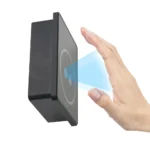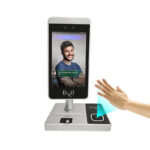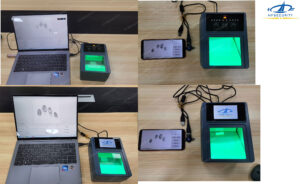This is the heading
How Palm Vein Recognition Works
Palm vein recognition is a contactless biometric technology that uses near-infrared light to capture the unique vein patterns inside a person’s hand. Since vein patterns are internal and nearly impossible to replicate, this method provides a high level of security. Moreover, palm vein scanners are less affected by skin conditions such as cuts, dryness, or dirt, making them highly reliable in real-world scenarios.
Key Features of Palm Vein Recognition:
Contactless Scanning – Reduces hygiene risks, ideal for healthcare and public areas.
High Security – Internal vein patterns are extremely difficult to forge or duplicate.
High Accuracy – Low false acceptance and rejection rates due to unique vein structures.
Durability – Works effectively across all ages and skin types, unaffected by external conditions.
Anti-Spoofing – Difficult to trick with photos, fingerprints, or masks.
Integration Friendly – Compatible with access control systems, attendance systems, banking, and other secure applications.
Fast Recognition – Quick scanning process, typically under a second for authentication.
Environmental Robustness – Less affected by dirt, moisture, or temperature changes compared to surface-based biometrics.
How Fingerprint Recognition Works
Fingerprint recognition identifies individuals based on the unique ridge and valley patterns on their fingertips. Fingerprint scanners can be capacitive, optical, or ultrasonic, each with varying levels of accuracy and security. While fingerprints are generally reliable, they can be affected by wear and tear, cuts, or dirt, which may reduce scanning accuracy.
Key Features of Fingerprint Recognition:
High Convenience – Quick and easy for daily use; widely recognized by users.
Cost-Effective – Fingerprint scanners are mature technology and less expensive than vein scanners.
Multiple Sensor Options – Capacitive, optical, and ultrasonic sensors provide flexibility for different applications.
Fast Verification – Typically authenticates users in a second or less.
Portable Compatibility – Commonly integrated into smartphones, laptops, and portable access devices.
Moderate Security – Effective for general use but can be spoofed if additional liveness detection is not implemented.
Scalable Deployment – Easily deployed in offices, schools, and commercial environments.
User-Friendly Enrollment – Simple enrollment process, suitable for large populations.
Palm Vein vs Fingerprint Recognition: Side-by-Side Comparison
| Feature | Пальма тамырларын тану | Саусақ ізін тану |
|---|---|---|
| Security Level | Very High – Internal vein patterns | Moderate – Surface patterns can be spoofed |
| Дәлдік | High – Minimal false acceptance | Moderate – Affected by skin conditions |
| Hygiene | Contactless, highly hygienic | Requires contact, prone to contamination |
| Durability & Reliability | Works for all ages and skin conditions | Can be less reliable due to cuts, dryness, or worn fingerprints |
| ҚОЛДАНУДЫҢ ҚАРАПАЙЫМДЫЛЫҒЫ | Moderate – Needs proper hand positioning | High – Simple fingerprint placement |
| Құны | Higher – Advanced technology | Lower – Mature and widely available |
| Common Applications | High-security facilities, banking, healthcare | Smartphones, office access, time attendance systems |
Enhanced Security – Internal vein patterns are unique and extremely difficult to forge.
Hygienic and Contactless – Ideal for workplaces or healthcare environments.
Reliable Across Demographics – Works effectively for elderly individuals and people with worn fingerprints.
Integration with Modern Systems – Easily integrates with access control, attendance management, and banking systems.
Widely Used and Recognized – Many users are familiar with fingerprint-based authentication.
Cost-Effective – Fingerprint scanners are more affordable for large-scale deployments.
Fast Authentication – Quick and convenient for daily use.
Mobile Integration – Easily used in smartphones and portable devices.
Conclusion: Which Is More Reliable?
Both palm vein and fingerprint recognition have their strengths and weaknesses. However, when it comes to security, hygiene, and reliability, palm vein recognition is generally more reliable, especially in environments that require high-security measures. On the other hand, fingerprint recognition remains a practical choice for cost-sensitive applications and daily convenience.
Ultimately, the choice depends on the specific security needs, budget, and user convenience. In high-security environments such as banking, healthcare, or government facilities, palm vein recognition is often the preferred solution. For consumer electronics or general office access, fingerprint recognition remains widely adopted.
Бізбен хабарласыңы
We would love to speak with you.
Feel free to reach out using the below details.





